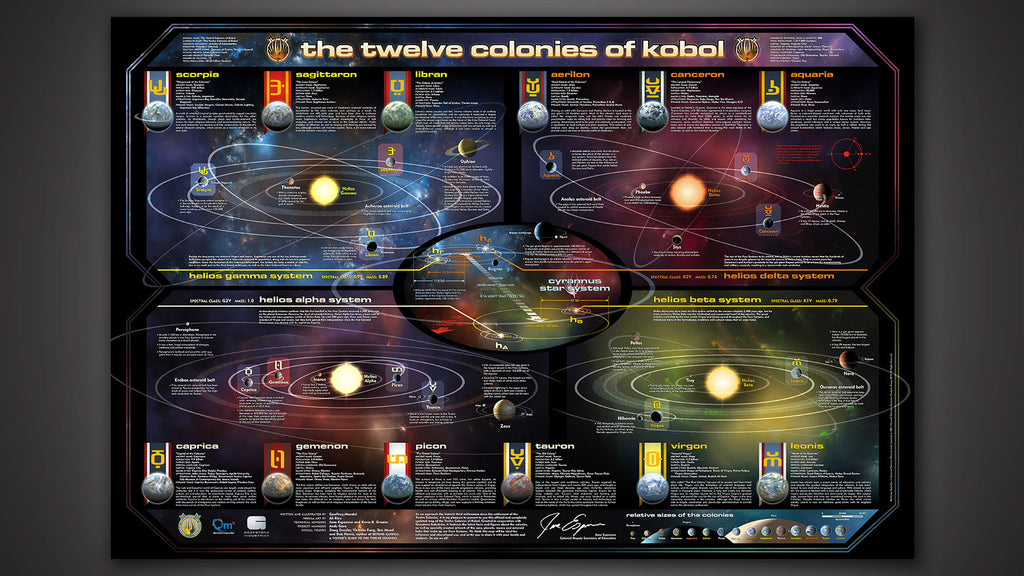I've talked about mapping the galaxy creatively before, and the focus of this entire blog is creatively realizing planets. Between those two tiers of worldbuilding, though, is the structure that forms the foundation of our understanding of outer space: the solar system. (Just FYI: when I refer to a "solar system" without capitalization, I'm referring to any system of stars and planets. When I capitalize "Solar System", I'm referring to ours. I believe a "star system" would technically refer to systems containing more than one star, with at least one orbiting the other.)
Now, when students are first taught about space, whether it's through primary school, picture books, or The Magic School Bus, they're usually taught about the eight or nine planets, in order.
 |
| Thus perpetuating the erroneous notion that they are always aligned in a neat little row. (Source) |
Supplemental material to movies and TV, on the other hand, seem more open to this kind of worldbuilding, though in reference books like the Star Wars Essential Atlas, it basically comes down to grabbing a handful of Scrabble tiles at random, throwing them onto the desk, and then rearranging them into something remotely pronounceable, accompanied by a terse description like "gas giant" or "airless rock".
For some reason though, seems like supplements to TV shows do solar systems better than other media.
 |
| (Source) |
This map, which you can explore in greater detail at the accompanying link, fleshes out those twelve worlds, and makes their destruction hit you all the harder because they're just so cool.
I talk a lot about variety and creativity when discussing alien worlds, but I like the approach taken to the twelve colony planets in this map. They're all distinctive in appearance, but they all adhere to largely the same color palette; they're not so much "alien planets" as they are "parallel Earths". The end result strikes a perfect balance between diversity and thematic consistency. The other planets, the gas giants and airless rocks, aren't important, but still get some flavor text.
I also love the setup of a quaternary star system, or a "binary binary," if you will. One could at least infer from the original version, and the remake made it explicit, that the Colonials had FTL. Yet in celestial terms, these planets are all still within spitting distance of each other. While it's unlikely that any star system could just happen to have twelve human-habitable worlds naturally - without terraforming, that's far from the least plausible thing in the franchise.
Predating the Battlestar Galactica map, yet taking its concept to the nth degree, is Firefly's "Complete and Official Map of the Verse."
 |
| Dun da-da-DAAAA!!! (Source) |
Follow the source links and you can take a much closer look at both maps. You can also explore the Firefly Verse with this app, though you will have to pay $4.99 as an in-app purchase to view the actual map.
I think I like these solar systems because they're so unconventional. Instead of just having a row of planets orbiting one star, we have a system that necessitates a map; simply listing the planets would be insufficient. Maybe it's the fact that these multiple-star systems seem more...asymmetrical than the typical solar system, granting a greater sense of realism to the fictitious universes? Or maybe it's just the complexity. Or all of the above.
There's really not a single configuration of planets or moons I can think of (and if I'm wrong, let me know) that isn't represented in one of these two maps. We have binary stars, binary planets (Caprica and Gemenon), planets sharing an orbit in each other's Lagrangian points (Angel and Zephyr), planets with rings, moons with rings, and - since some of these stars were once planets - moons of moons!
Now, it's not likely for moons to have moons of their own. Natural satellites tend to have smaller Hill spheres, or areas of gravitational dominance, so the existence of a parent planet makes any moons of those moons have unstable and thus ephemeral orbits. However, the universe is a vast place. So if we ever do find a moon that has a moon of its own moon moon moon moooooooooooooooooooooon...
Excuse me.
We need a term for a moon's moon. I propose the term "metamoon." The Greek prefix "meta-", meaning "after" or "beyond" seems fitting to denote a new tier of satellite. Planets orbit stars, moons orbit planets, and metamoons orbit moons. Also, we often associate the prefix with the idea of recursion, as in "metacognition" (thinking about thinking) or "metafiction" (fiction about fiction). So a metamoon is a moon of a moon. Moooooon.
Of course, not all sci-fi solar systems need to be this complex. I'd just be happy to know how many moons a planet has and what their names are. It's just that attention to detail that makes the work's universe so intriguing.
Also, if you're going to construct a solar system, try to follow a theme when naming the planets, like how the planets in our own Solar System are named from Roman mythology. The Twelve Colonies all are named for the Zodiac. Rodina uses Slavic mythology.
As a last note, here's a solar system I whipped up in MS Paint as my friend and I were trading story ideas. Note the theme of Arthurian legend figures I use here. And also note that I use the terms "whipped up" and "MS Paint" to explain why it's so crude:


Excellent and very exciting site. Love to watch. Keep Rocking.
ReplyDeletesan antonio solar